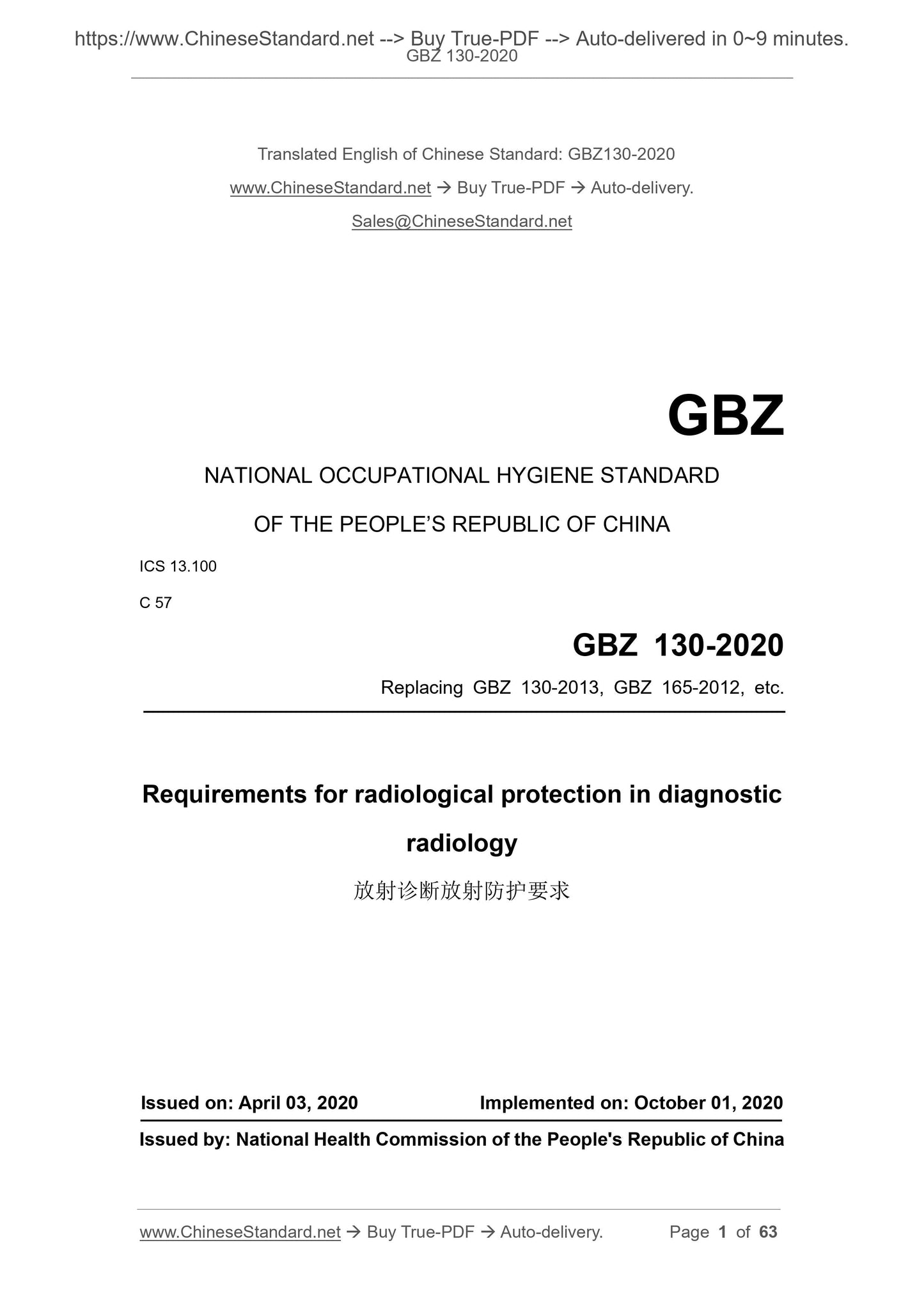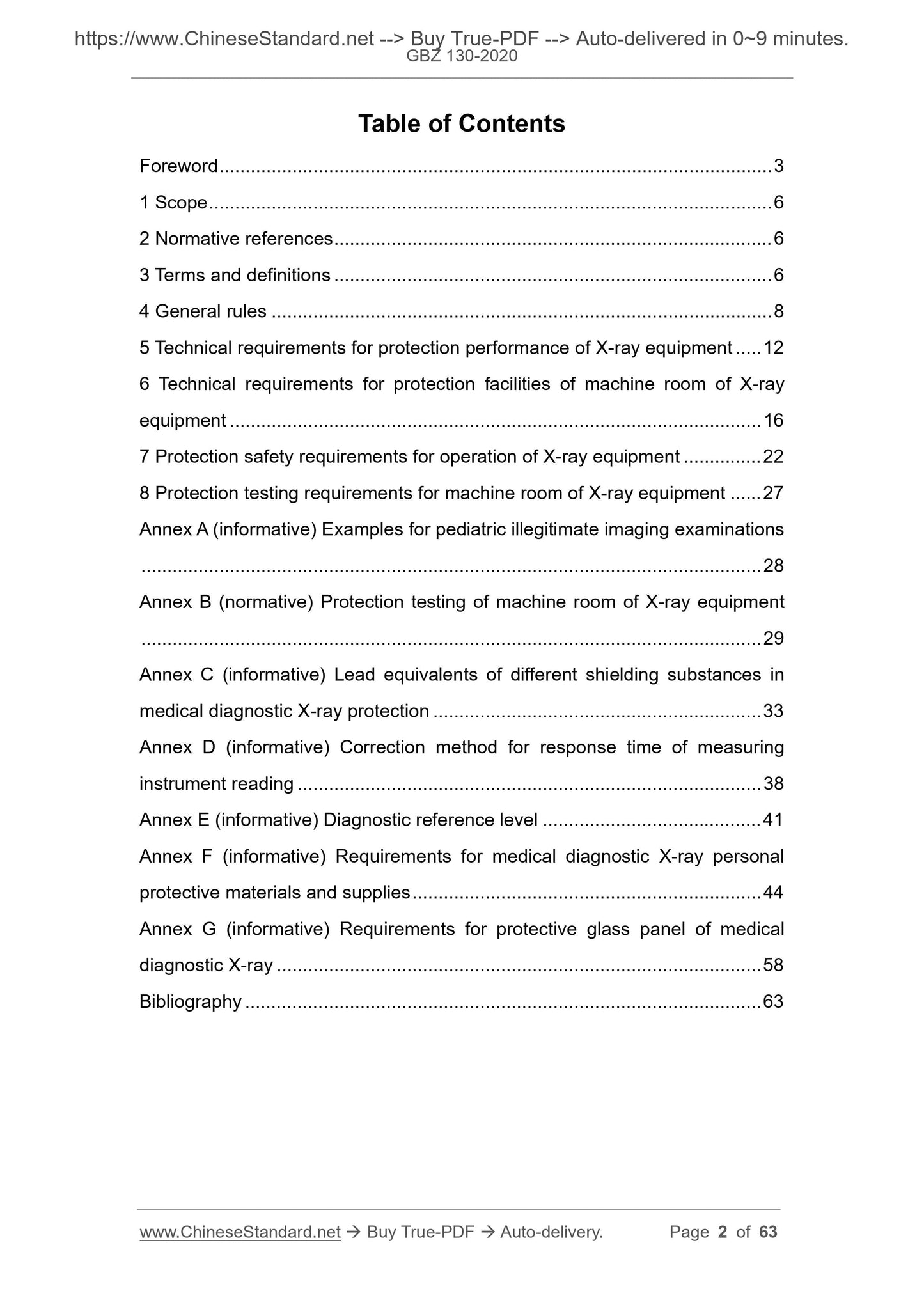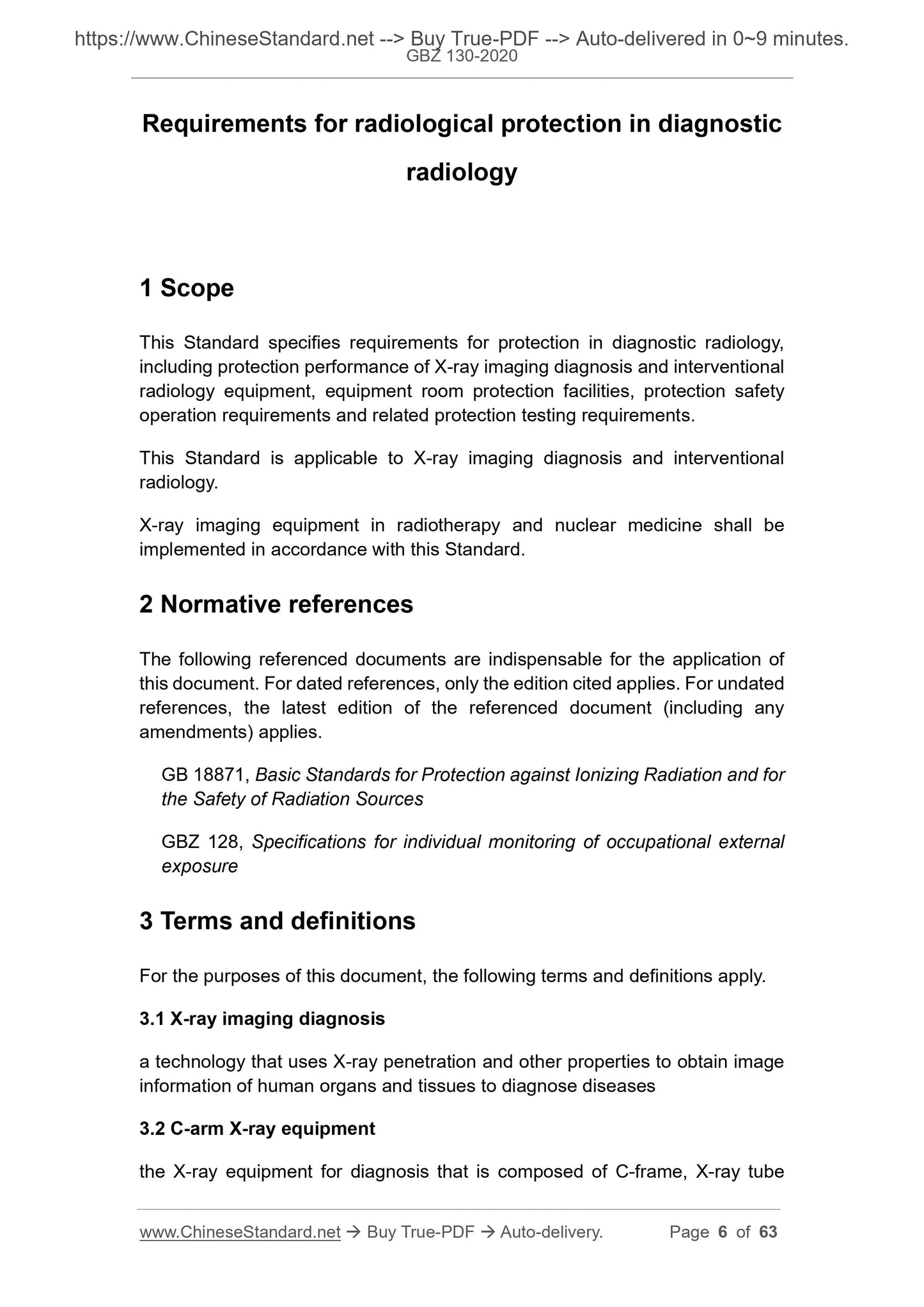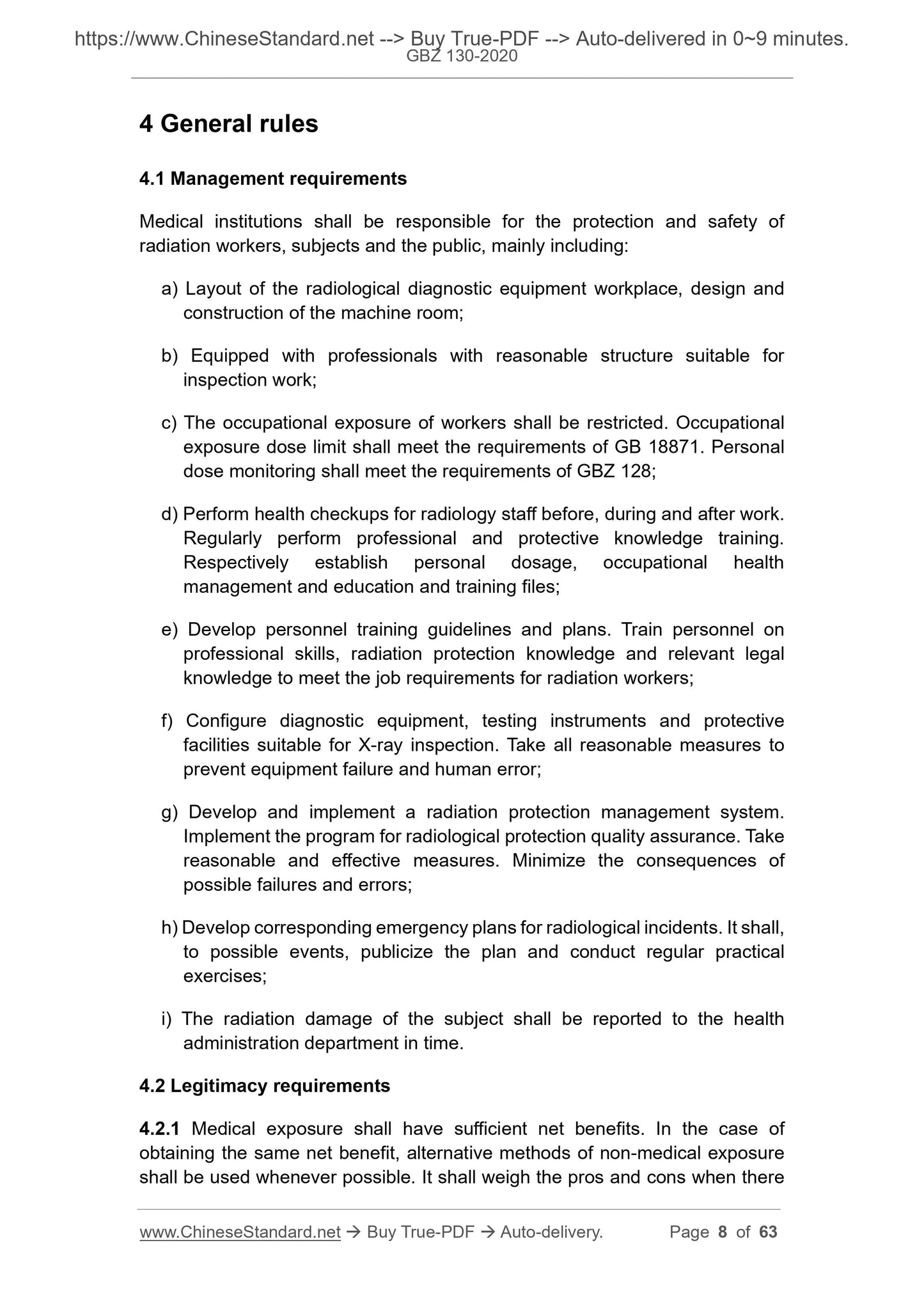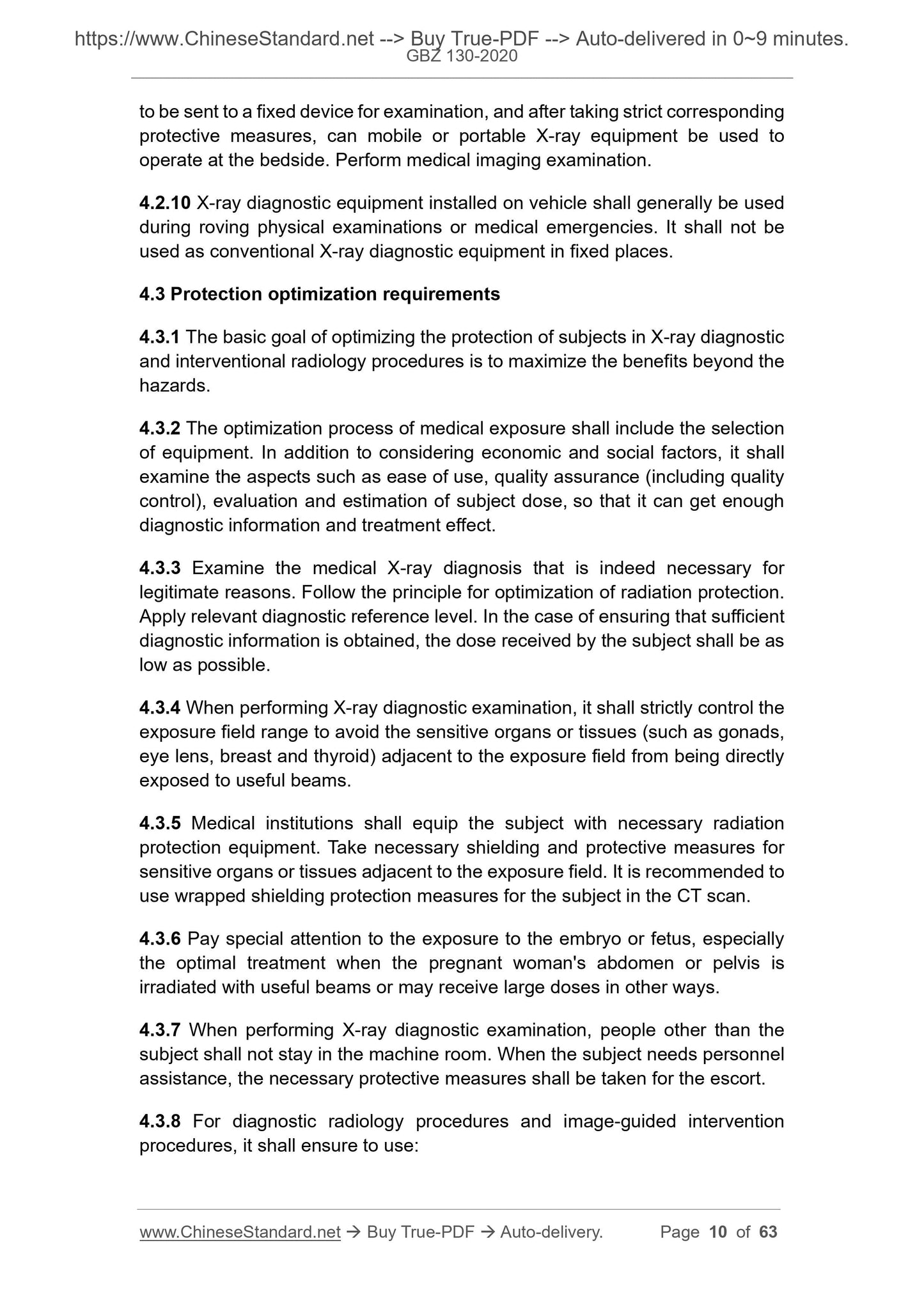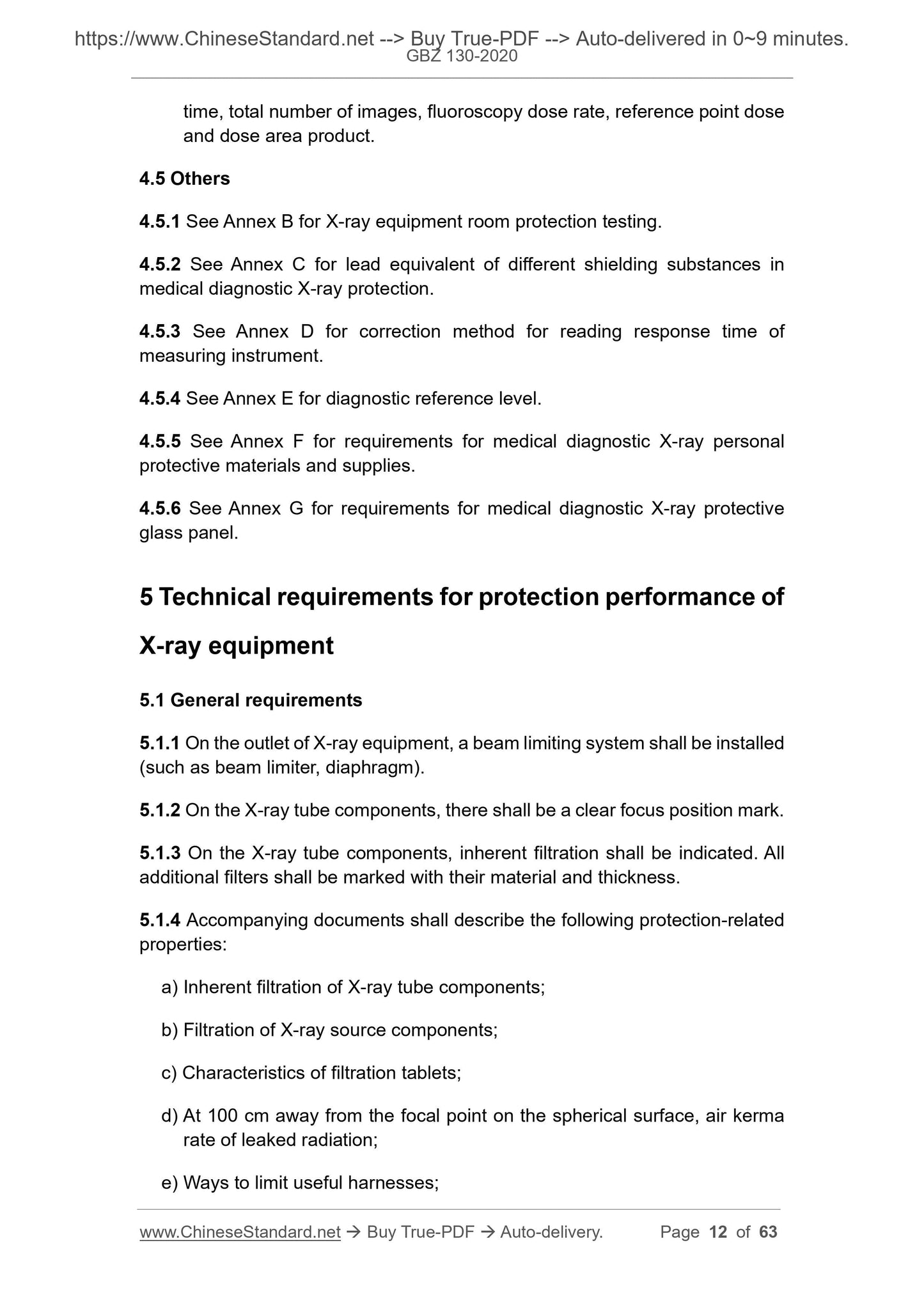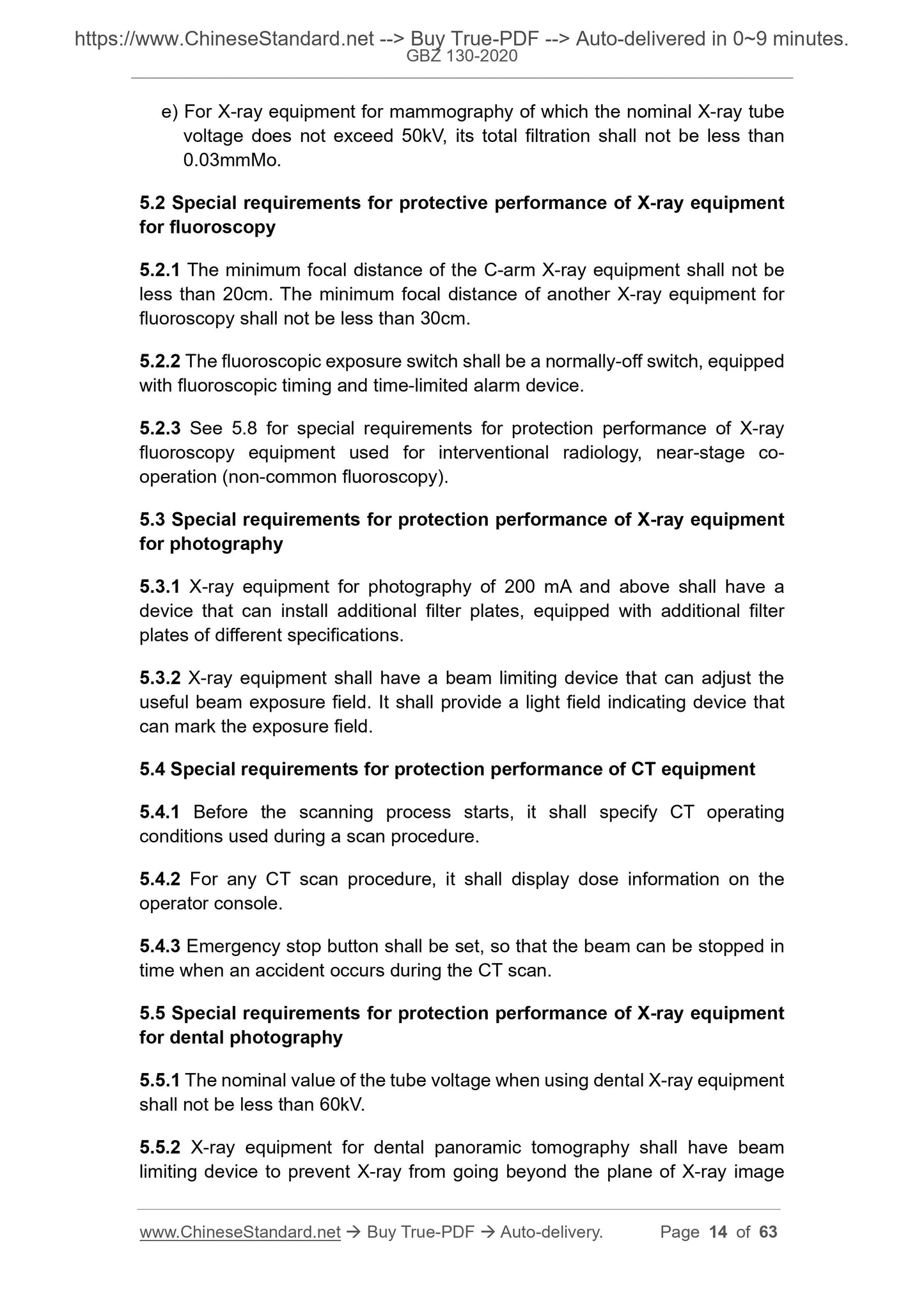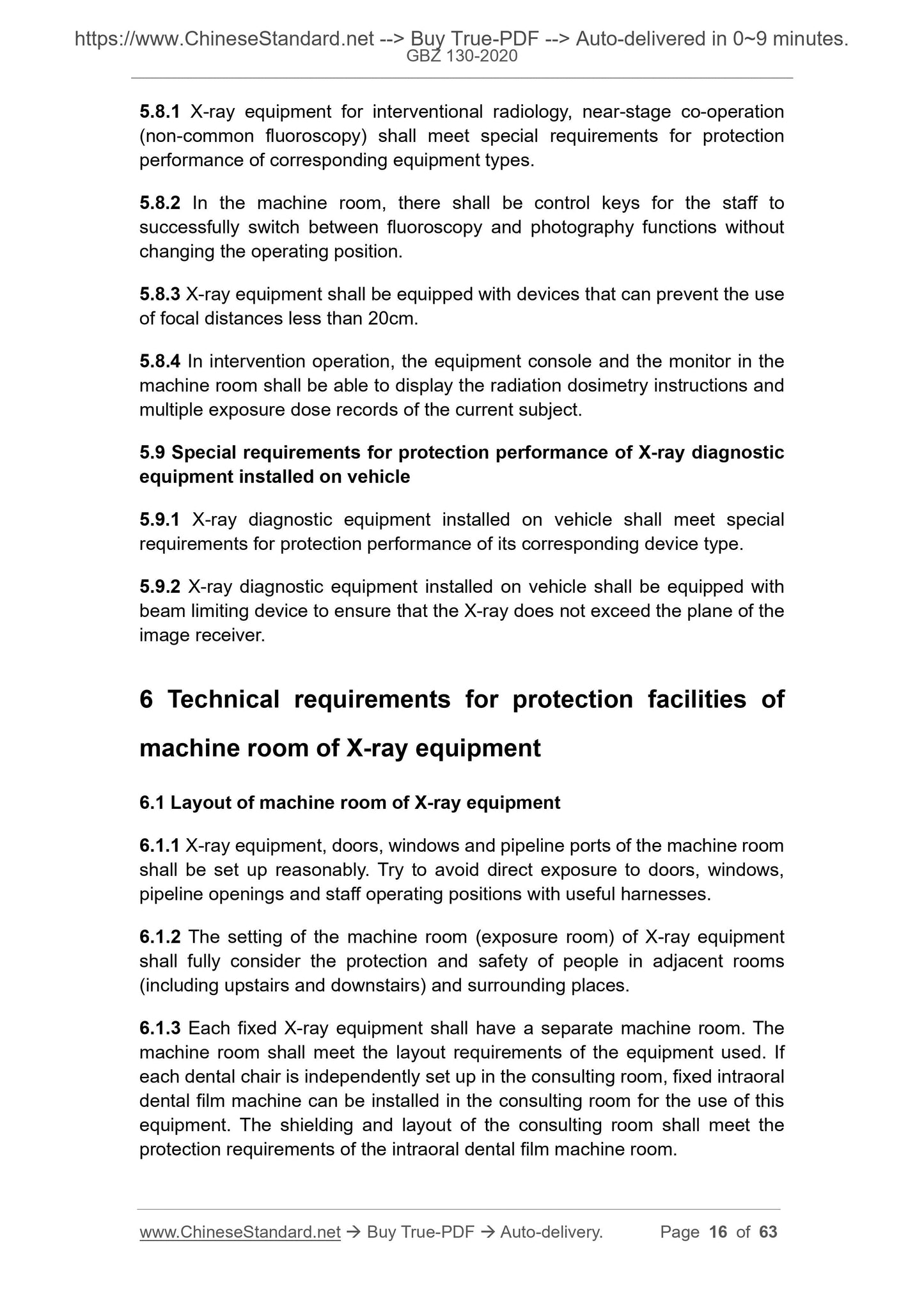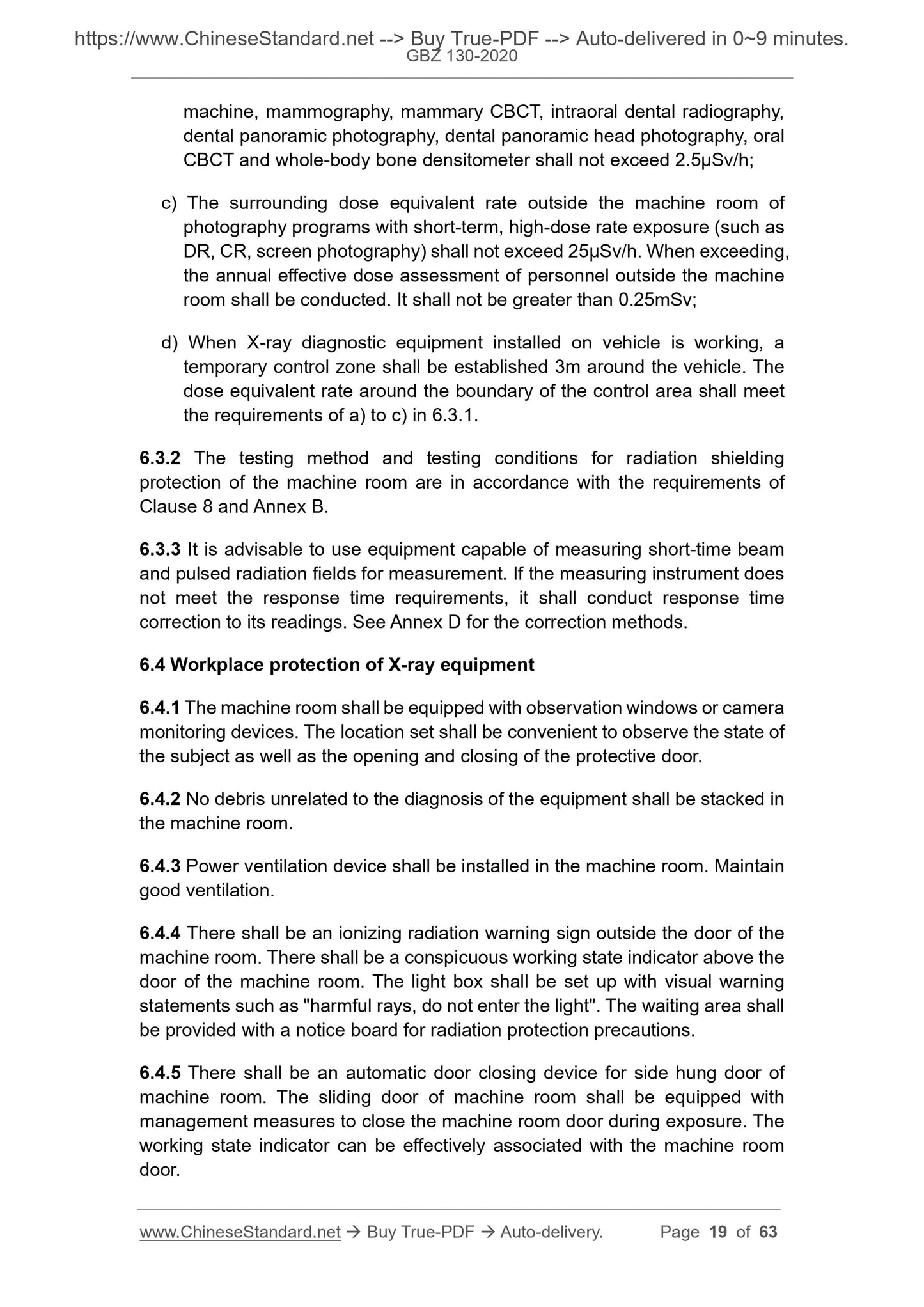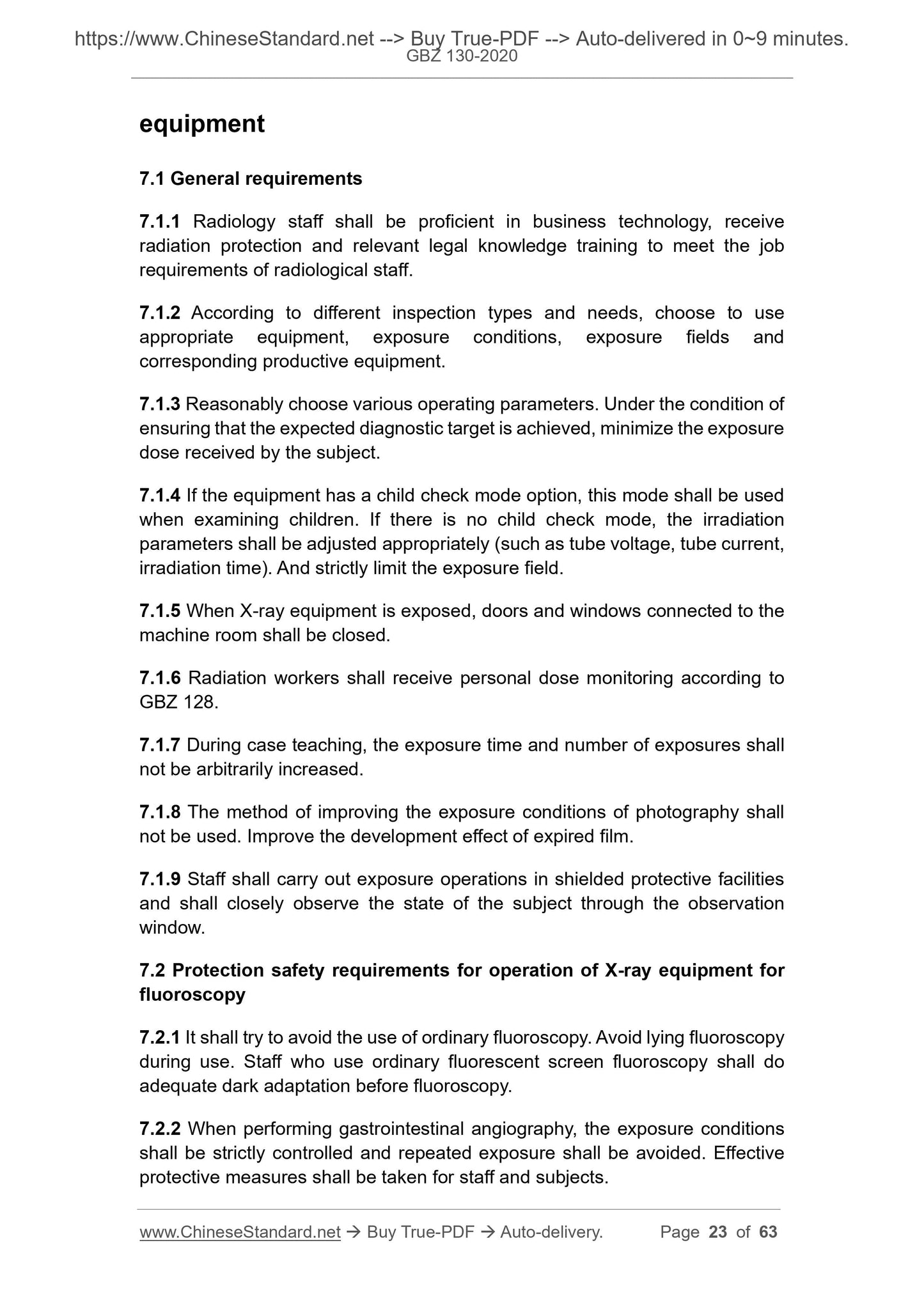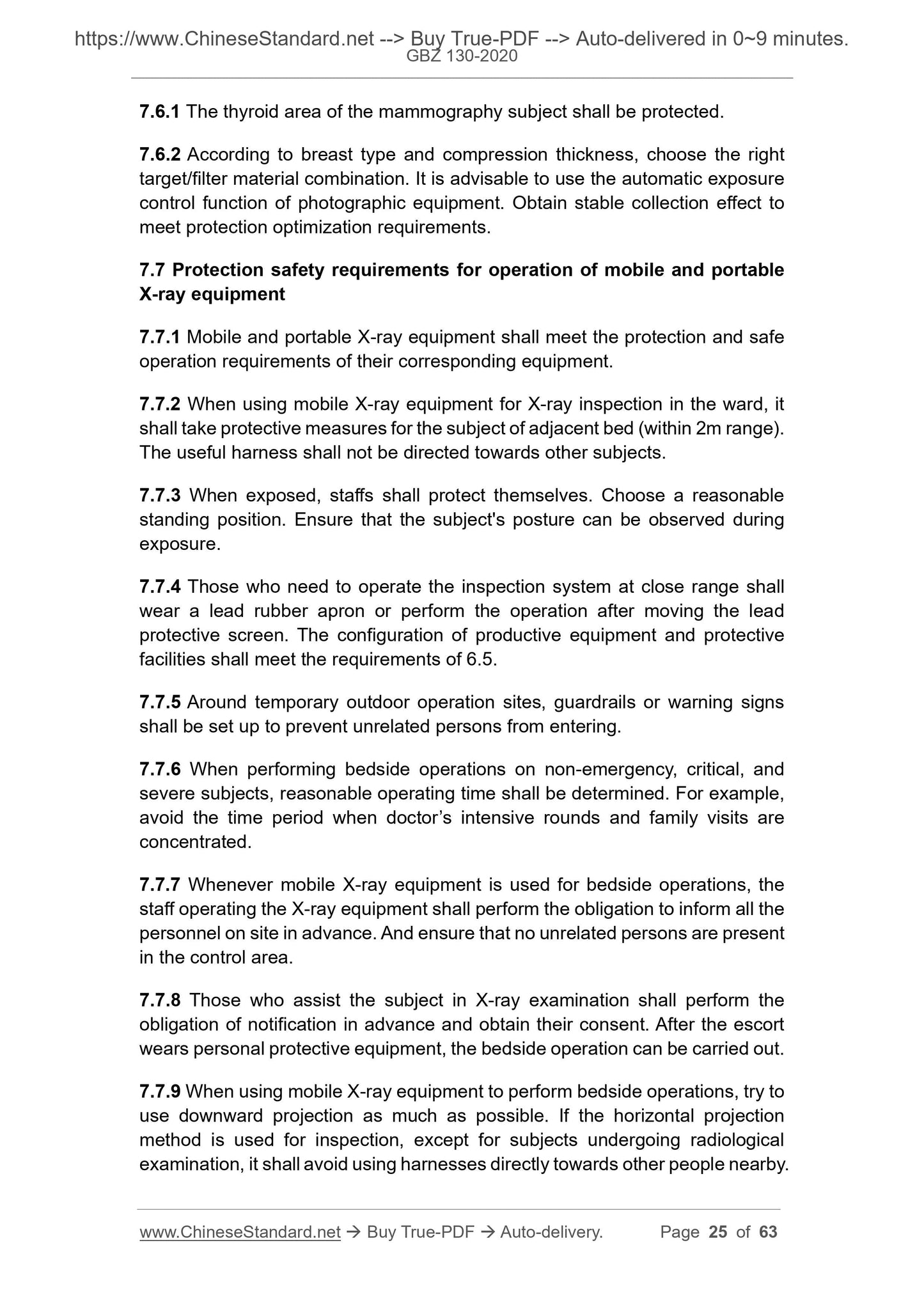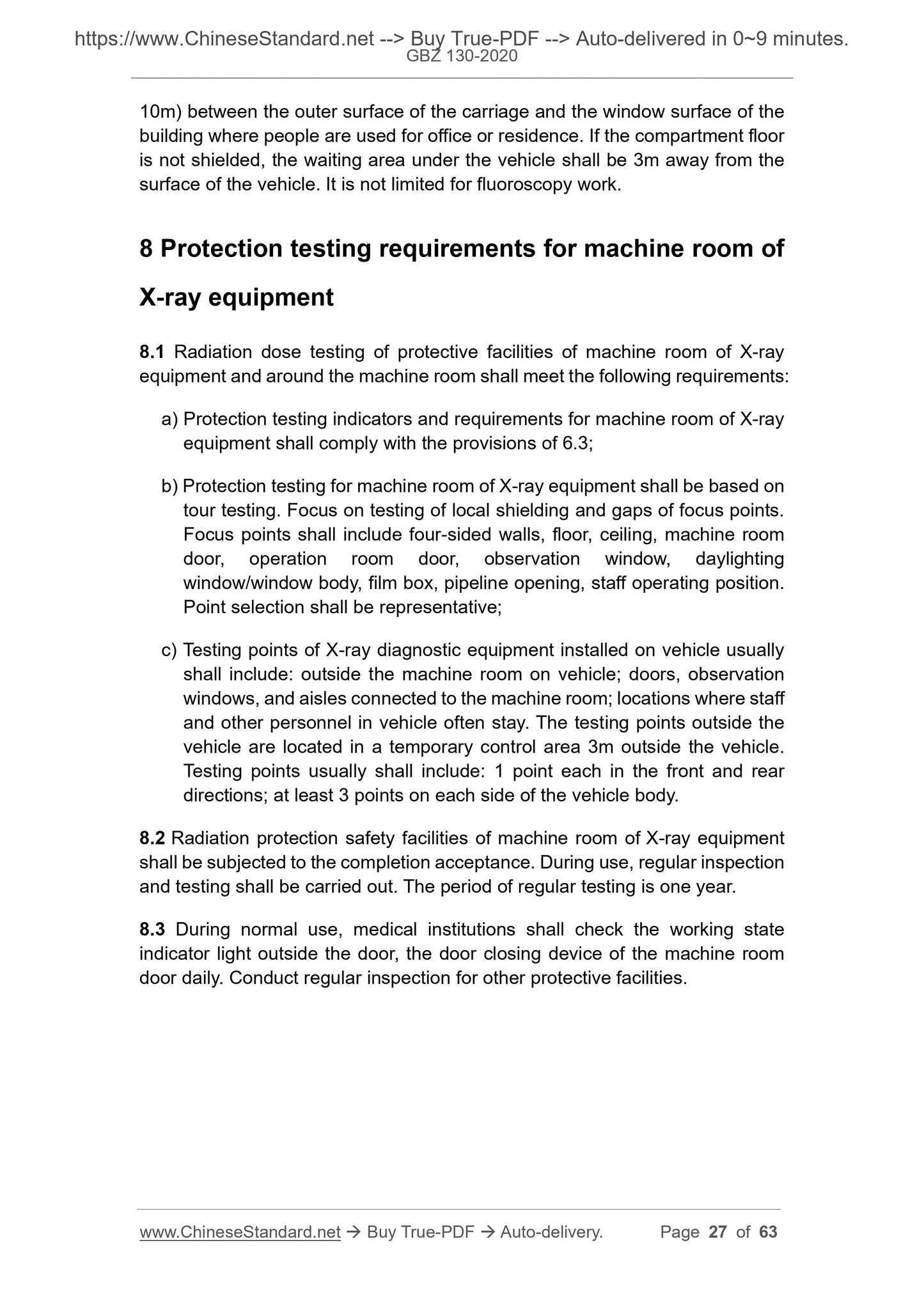1
/
of
12
PayPal, credit cards. Download editable-PDF and invoice in 1 second!
GBZ 130-2020 English PDF (GBZ130-2020)
GBZ 130-2020 English PDF (GBZ130-2020)
Regular price
$495.00 USD
Regular price
Sale price
$495.00 USD
Unit price
/
per
Shipping calculated at checkout.
Couldn't load pickup availability
Delivery: 3 seconds. Download true-PDF + Invoice.
Get QUOTATION in 1-minute: Click GBZ 130-2020
Historical versions: GBZ 130-2020
Preview True-PDF (Reload/Scroll if blank)
GBZ 130-2020: Requirements for radiological protection in diagnostic radiology
GBZ 130-2020
GBZ
NATIONAL OCCUPATIONAL HYGIENE STANDARD
OF THE PEOPLE’S REPUBLIC OF CHINA
ICS 13.100
C 57
Replacing GBZ 130-2013, GBZ 165-2012, etc.
Requirements for radiological protection in diagnostic
radiology
ISSUED ON: APRIL 03, 2020
IMPLEMENTED ON: OCTOBER 01, 2020
Issued by: National Health Commission of the People's Republic of China
Table of Contents
Foreword ... 3
1 Scope ... 6
2 Normative references ... 6
3 Terms and definitions ... 6
4 General rules ... 8
5 Technical requirements for protection performance of X-ray equipment ... 12
6 Technical requirements for protection facilities of machine room of X-ray
equipment ... 16
7 Protection safety requirements for operation of X-ray equipment ... 22
8 Protection testing requirements for machine room of X-ray equipment ... 27
Annex A (informative) Examples for pediatric illegitimate imaging examinations
... 28
Annex B (normative) Protection testing of machine room of X-ray equipment
... 29
Annex C (informative) Lead equivalents of different shielding substances in
medical diagnostic X-ray protection ... 33
Annex D (informative) Correction method for response time of measuring
instrument reading ... 38
Annex E (informative) Diagnostic reference level ... 41
Annex F (informative) Requirements for medical diagnostic X-ray personal
protective materials and supplies ... 44
Annex G (informative) Requirements for protective glass panel of medical
diagnostic X-ray ... 58
Bibliography ... 63
Requirements for radiological protection in diagnostic
radiology
1 Scope
This Standard specifies requirements for protection in diagnostic radiology,
including protection performance of X-ray imaging diagnosis and interventional
radiology equipment, equipment room protection facilities, protection safety
operation requirements and related protection testing requirements.
This Standard is applicable to X-ray imaging diagnosis and interventional
radiology.
X-ray imaging equipment in radiotherapy and nuclear medicine shall be
implemented in accordance with this Standard.
2 Normative references
The following referenced documents are indispensable for the application of
this document. For dated references, only the edition cited applies. For undated
references, the latest edition of the referenced document (including any
amendments) applies.
GB 18871, Basic Standards for Protection against Ionizing Radiation and for
the Safety of Radiation Sources
GBZ 128, Specifications for individual monitoring of occupational external
exposure
3 Terms and definitions
For the purposes of this document, the following terms and definitions apply.
3.1 X-ray imaging diagnosis
a technology that uses X-ray penetration and other properties to obtain image
information of human organs and tissues to diagnose diseases
3.2 C-arm X-ray equipment
the X-ray equipment for diagnosis that is composed of C-frame, X-ray tube
4 General rules
4.1 Management requirements
Medical institutions shall be responsible for the protection and safety of
radiation workers, subjects and the public, mainly including:
a) Layout of the radiological diagnostic equipment workplace, design and
construction of the machine room;
b) Equipped with professionals with reasonable structure suitable for
inspection work;
c) The occupational exposure of workers shall be restricted. Occupational
exposure dose limit shall meet the requirements of GB 18871. Personal
dose monitoring shall meet the requirements of GBZ 128;
d) Perform health checkups for radiology staff before, during and after work.
Regularly perform professional and protective knowledge training.
Respectively establish personal dosage, occupational health
management and education and training files;
e) Develop personnel training guidelines and plans. Train personnel on
professional skills, radiation protection knowledge and relevant legal
knowledge to meet the job requirements for radiation workers;
f) Configure diagnostic equipment, testing instruments and protective
facilities suitable for X-ray inspection. Take all reasonable measures to
prevent equipment failure and human error;
g) Develop and implement a radiation protection management system.
Implement the program for radiological protection quality assurance. Take
reasonable and effective measures. Minimize the consequences of
possible failures and errors;
h) Develop corresponding emergency plans for radiological incidents. It shall,
to possible events, publicize the plan and conduct regular practical
exercises;
i) The radiation damage of the subject shall be reported to the health
administration department in time.
4.2 Legitimacy requirements
4.2.1 Medical exposure shall have sufficient net benefits. In the case of
obtaining the same net benefit, alternative methods of non-medical exposure
shall be used whenever possible. It shall weigh the pros and cons when there
to be sent to a fixed device for examination, and after taking strict corresponding
protective measures, can mobile or portable X-ray equipment be used to
operate at the bedside. Perform medical imaging examination.
4.2.10 X-ray diagnostic equipment installed on vehicle shall generally be used
during roving physical examinations or medical emergencies. It shall not be
used as conventional X-ray diagnostic equipment in fixed places.
4.3 Protection optimization requirements
4.3.1 The basic goal of optimizing the protection of subjects in X-ray diagnostic
and interventional radiology procedures is to maximize the benefits beyond the
hazards.
4.3.2 The optimization process of medical exposure shall include the selection
of equipment. In addition to considering economic and social factors, it shall
examine the aspects such as ease of use, quality assurance (including quality
control), evaluation and estimation of subject dose, so that it can get enough
diagnostic information and treatment effect.
4.3.3 Examine the medical X-ray diagnosis that is indeed necessary for
legitimate reasons. Follow the principle for optimization of radiation protection.
Apply relevant diagnostic reference level. In the case of ensuring that sufficient
diagnostic information is obtained, the dose received by the subject shall be as
low as possible.
4.3.4 When performing X-ray diagnostic examination, it shall strictly control the
exposure field range to avoid the sensitive organs or tissues (such as gonads,
eye lens, breast and thyroid) adjacent to the exposure field from being directly
exposed to useful beams.
4.3.5 Medical institutions shall equip the subject with necessary radiation
protection equipment. Take necessary shielding and protective measures for
sensitive organs or tissues adjacent to the exposure field. It is recommended to
use wrapped shielding protection measures for the subject in the CT scan.
4.3.6 Pay special attention to the exposure to the embryo or fetus, especially
the optimal treatment when the pregnant woman's abdomen or pelvis is
irradiated with useful beams or may receive large doses in other ways.
4.3.7 When performing X-ray diagnostic examination, people other than the
subject shall not stay in the machine room. When the subject needs personnel
assistance, the necessary protective measures shall be taken for the escort.
4.3.8 For diagnostic radiology procedures and image-guided intervention
procedures, it shall ensure to use:
Get QUOTATION in 1-minute: Click GBZ 130-2020
Historical versions: GBZ 130-2020
Preview True-PDF (Reload/Scroll if blank)
GBZ 130-2020: Requirements for radiological protection in diagnostic radiology
GBZ 130-2020
GBZ
NATIONAL OCCUPATIONAL HYGIENE STANDARD
OF THE PEOPLE’S REPUBLIC OF CHINA
ICS 13.100
C 57
Replacing GBZ 130-2013, GBZ 165-2012, etc.
Requirements for radiological protection in diagnostic
radiology
ISSUED ON: APRIL 03, 2020
IMPLEMENTED ON: OCTOBER 01, 2020
Issued by: National Health Commission of the People's Republic of China
Table of Contents
Foreword ... 3
1 Scope ... 6
2 Normative references ... 6
3 Terms and definitions ... 6
4 General rules ... 8
5 Technical requirements for protection performance of X-ray equipment ... 12
6 Technical requirements for protection facilities of machine room of X-ray
equipment ... 16
7 Protection safety requirements for operation of X-ray equipment ... 22
8 Protection testing requirements for machine room of X-ray equipment ... 27
Annex A (informative) Examples for pediatric illegitimate imaging examinations
... 28
Annex B (normative) Protection testing of machine room of X-ray equipment
... 29
Annex C (informative) Lead equivalents of different shielding substances in
medical diagnostic X-ray protection ... 33
Annex D (informative) Correction method for response time of measuring
instrument reading ... 38
Annex E (informative) Diagnostic reference level ... 41
Annex F (informative) Requirements for medical diagnostic X-ray personal
protective materials and supplies ... 44
Annex G (informative) Requirements for protective glass panel of medical
diagnostic X-ray ... 58
Bibliography ... 63
Requirements for radiological protection in diagnostic
radiology
1 Scope
This Standard specifies requirements for protection in diagnostic radiology,
including protection performance of X-ray imaging diagnosis and interventional
radiology equipment, equipment room protection facilities, protection safety
operation requirements and related protection testing requirements.
This Standard is applicable to X-ray imaging diagnosis and interventional
radiology.
X-ray imaging equipment in radiotherapy and nuclear medicine shall be
implemented in accordance with this Standard.
2 Normative references
The following referenced documents are indispensable for the application of
this document. For dated references, only the edition cited applies. For undated
references, the latest edition of the referenced document (including any
amendments) applies.
GB 18871, Basic Standards for Protection against Ionizing Radiation and for
the Safety of Radiation Sources
GBZ 128, Specifications for individual monitoring of occupational external
exposure
3 Terms and definitions
For the purposes of this document, the following terms and definitions apply.
3.1 X-ray imaging diagnosis
a technology that uses X-ray penetration and other properties to obtain image
information of human organs and tissues to diagnose diseases
3.2 C-arm X-ray equipment
the X-ray equipment for diagnosis that is composed of C-frame, X-ray tube
4 General rules
4.1 Management requirements
Medical institutions shall be responsible for the protection and safety of
radiation workers, subjects and the public, mainly including:
a) Layout of the radiological diagnostic equipment workplace, design and
construction of the machine room;
b) Equipped with professionals with reasonable structure suitable for
inspection work;
c) The occupational exposure of workers shall be restricted. Occupational
exposure dose limit shall meet the requirements of GB 18871. Personal
dose monitoring shall meet the requirements of GBZ 128;
d) Perform health checkups for radiology staff before, during and after work.
Regularly perform professional and protective knowledge training.
Respectively establish personal dosage, occupational health
management and education and training files;
e) Develop personnel training guidelines and plans. Train personnel on
professional skills, radiation protection knowledge and relevant legal
knowledge to meet the job requirements for radiation workers;
f) Configure diagnostic equipment, testing instruments and protective
facilities suitable for X-ray inspection. Take all reasonable measures to
prevent equipment failure and human error;
g) Develop and implement a radiation protection management system.
Implement the program for radiological protection quality assurance. Take
reasonable and effective measures. Minimize the consequences of
possible failures and errors;
h) Develop corresponding emergency plans for radiological incidents. It shall,
to possible events, publicize the plan and conduct regular practical
exercises;
i) The radiation damage of the subject shall be reported to the health
administration department in time.
4.2 Legitimacy requirements
4.2.1 Medical exposure shall have sufficient net benefits. In the case of
obtaining the same net benefit, alternative methods of non-medical exposure
shall be used whenever possible. It shall weigh the pros and cons when there
to be sent to a fixed device for examination, and after taking strict corresponding
protective measures, can mobile or portable X-ray equipment be used to
operate at the bedside. Perform medical imaging examination.
4.2.10 X-ray diagnostic equipment installed on vehicle shall generally be used
during roving physical examinations or medical emergencies. It shall not be
used as conventional X-ray diagnostic equipment in fixed places.
4.3 Protection optimization requirements
4.3.1 The basic goal of optimizing the protection of subjects in X-ray diagnostic
and interventional radiology procedures is to maximize the benefits beyond the
hazards.
4.3.2 The optimization process of medical exposure shall include the selection
of equipment. In addition to considering economic and social factors, it shall
examine the aspects such as ease of use, quality assurance (including quality
control), evaluation and estimation of subject dose, so that it can get enough
diagnostic information and treatment effect.
4.3.3 Examine the medical X-ray diagnosis that is indeed necessary for
legitimate reasons. Follow the principle for optimization of radiation protection.
Apply relevant diagnostic reference level. In the case of ensuring that sufficient
diagnostic information is obtained, the dose received by the subject shall be as
low as possible.
4.3.4 When performing X-ray diagnostic examination, it shall strictly control the
exposure field range to avoid the sensitive organs or tissues (such as gonads,
eye lens, breast and thyroid) adjacent to the exposure field from being directly
exposed to useful beams.
4.3.5 Medical institutions shall equip the subject with necessary radiation
protection equipment. Take necessary shielding and protective measures for
sensitive organs or tissues adjacent to the exposure field. It is recommended to
use wrapped shielding protection measures for the subject in the CT scan.
4.3.6 Pay special attention to the exposure to the embryo or fetus, especially
the optimal treatment when the pregnant woman's abdomen or pelvis is
irradiated with useful beams or may receive large doses in other ways.
4.3.7 When performing X-ray diagnostic examination, people other than the
subject shall not stay in the machine room. When the subject needs personnel
assistance, the necessary protective measures shall be taken for the escort.
4.3.8 For diagnostic radiology procedures and image-guided intervention
procedures, it shall ensure to use:
Share
